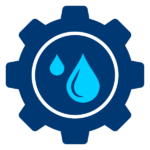
CloseClose to Continue


Water disinfection means the removal, deactivation or killing of pathogenic microorganisms. Microorganisms are destroyed or deactivated, resulting in termination of growth and reproduction. When microorganisms are not removed from drinking water, drinking water usage will cause people to fall ill.
Sterilization is a process related to disinfection. However, during the sterilization process all present microorganisms are killed, both harmful and harmless microorganisms.
Water purification means the process of removing undesirable chemicals, biological contaminants, suspended solids, and gases from water. The goal is to produce water that is fit for specific purposes. Most water is purified and disinfected for human consumption, but water purification may also be carried out for a variety of other purposes, including medical, pharmacological, chemical, and industrial applications.
Clarification is an essential step in a water or wastewater treatment process to remove suspended solids through gravity settling, providing a clarified liquid effluent. First, understanding primary and secondary clarification is needed to determine the appropriate technology to meet treatment requirements.
A deionized water system is an arrangement of DI tanks and other components that are used to produce high purity water. The DI tanks are typically made of fiberglass and come in various sizes to accommodate different feed flow rates. A deionized water system can be as simple as a one tank setup or as complex as a multi-tank system with supporting equipment such as reverse osmosis, ultraviolet (UV) disinfection and elaborate water quality monitoring equipment. DI tanks contain ion exchange resin which selectively remove ions from water. Eventually the DI tanks need to be replaced by the service provider and replaced with a fresh tank. Many customers require standby DI tanks onsite to make sure they have an uninterrupted flow of deionized water. The DI tank exchange frequency depends on the incoming water quality and the amount of water being used. The higher ionic load in the incoming feed water will result in less gallonage produced by the DI tank.
Reverse osmosis is a water purification process that uses a semi-permeable membrane (synthetic lining) to filter out unwanted molecules and large particles such as contaminants and sediments like chlorine, salt, and dirt from drinking water. In addition to removing contaminants and sediments, reverse osmosis can also remove microorganisms – which you certainly do not want to drink. It gets water clean down to a molecular level, leaving only pure H2O behind.
Water filtration is the process of removing or reducing the concentration of particulate matter, including suspended particles, parasites, bacteria, algae, viruses, and fungi, as well as other undesirable chemical and biological contaminants from contaminated water to produce safe and clean water for a specific purpose, such as drinking, medical, and pharmaceutical applications.
By degassing the water, unwanted oxygen or carbonic acid is removed. Reduction of oxygen and carbonic acid content minimize the risk of corrosion significantly. Degassing systems are used especially for boiler water, district heating water and circulating water.
A necessary part of all municipal and industrial wastewater treatment plants, wastewater screening retains solids found in the wastewater. These solids must be removed at the very beginning of the water treatment process, as these solids could make the whole system less efficient, damage expensive and essential water treatment equipment or contaminate water, causing small to large scale natural upsets for a region’s entire ecosystem.














27 Old Gloucester Street, London, United Kingdom, WC1N 3AX